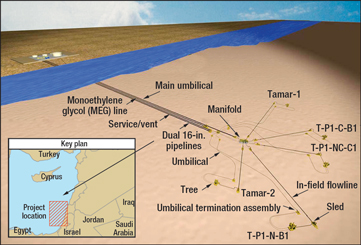|
Vol. 231 No. 4 |

|
|
DAVID MICHAEL COHEN, MANAGING EDITOR
|
A land flowing with milk, honey and natural gas
“Let me tell you something that we Israelis have against Moses. He took us 40 years through the desert in order to bring us to the one spot in the Middle East that has no oil!”
—Golda Meir, 1973
If Golda Meir were alive today, she might owe Moses an apology. Israel still has no oil reserves to speak of, but if the giant Tamar offshore natural gas discovery is any indication, then perhaps the leader of the Exodus knew what he was doing after all.
Discovered in November 2008 by Noble Energy and Israeli Partners Isramco Negev, Delek Drilling, Avner Oil Exploration and Dor Gas Exploration, the 6.3-Tcf find in the eastern Mediterranean is the biggest in the country’s history, representing 40 years of electrical supply at current demand levels, or 15–20 years at projected growth. It is also the second-largest gas find worldwide since Jan. 1, 2008, right after Petrobras’ giant Jupiter subsalt discovery off Brazil. Shortly after the Tamar discovery, Noble found an additional 0.5 Tcf at the nearby Dalit prospect.
The implications of gas production from these discoveries for Israel are profound, affecting energy security, infrastructure and trade relations. As Noble Chairman and CEO Chuck Davidson was quoted as saying in a November Oil and Gas Investor article, “It’s not very often you get to be part of an exploration venture that has the potential to dramatically change a country’s energy supply.”
 |
Fig. 1. The proposed development scheme for Tamar Field is a subsea production system tied back to an onshore terminal south of Haifa. Courtesy of Noble Energy.
|
|
Development plan. The $2.5–$3 billion development plan calls for subsea production of Tamar gas and delivery via a high-pressure, dual 16-in. subsea pipeline to an onshore distribution terminal 90 km away near Dor, 20 km south of Haifa. A subsea monoethylene glycol (MEG) line will provide flow assurance for the gas being produced from the field. Though Noble declined to comment on whether Dalit production would eventually be tied into the same system, the smaller discovery does lie close to the Tamar pipelines’ path, about 30 km from shore.
Davidson told reporters last month that Noble expects first production of 750 MMcfd by 2012—greater than the country’s projected gas demand for that year. Israeli officials have been less optimistic, saying in February that they don’t expect gas deliveries from Tamar until the following year.
The project is not without its technical challenges. Delivering gas from far offshore is never easy, and generally requires some form of expensive treatment. According to a March 17 article in the Israeli newspaper Haaretz, Noble plans to deliver the gas at a very high pressure of 400–500 bars, much more than the 80–100 bars at which current Israeli gas supplies are delivered.
High-pressure delivery reduces the cost of production by offering more flexibility in terms of swing production and by eliminating the need to add subsea compressors as the field depletes. However, experts in the Israeli infrastructure ministry have recently raised safety concerns about delivering the gas at such high pressure.
Implications. Tamar gas could be the answer to Israel’s prayers in many respects. The country has been greatly expanding its natural gas use, and its use of gas for electrical generation jumped from zero before 2003 to about 40% of electrical supply today.
Israel only has two sources for this natural gas: Mari-B Field in the Mediterranean and pipeline imports from Egypt. Mari-B, which was also discovered by Noble in 2000 with 1 Tcf of initial reserves, will be depleted in a few years. Egypt has supplied gas to Israel since 2005, but the sales have faced protests and legal challenges in that country, including a court-imposed ban on gas sales to Israel that was just recently overturned by Egypt’s high court. This supply insecurity had Israel looking into potential Russian or LNG supplies, but the Tamar and Dalit discoveries have changed the picture dramatically, offering Israel the prospect of near energy independence for the first time.
There are big plans brewing for all that gas. Israel is investing around $1 billion in its gas distribution network, set to cover 90% of the country in 2013, to meet an expected increase in annual demand to 350–420 Bcf in 2016, from about 140 Bcf now.
Long-term domestic gas supply would also benefit Israel’s effort to reduce its dependence on foreign oil by electrifying its auto fleet. California-based company Better Place is in the process of rolling out its first electric vehicle service network in Israel. The first charging spot opened in 2008 at a cinema car park in Pi-Glilot, and public networks in Tel Aviv, Haifa, Kefar Sava, Holon and Jerusalem are also being planned and installed.
In a land where even the commonplace takes on biblical proportions, it’s easy to see an epic role for natural gas exploration and production activities in the years to come. 
|




